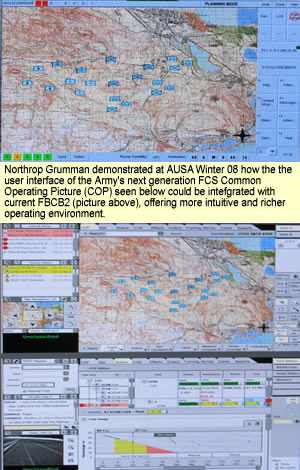Since its first deployment in the early 2000s, the Army’s FBCB2 command and control system was proven as one of the most valuable command and control combat assets. Incorporating the latest developments in digital information processing and networking, DRS Technologies, the hardware subcontractor for Northrop Grumman, began shipments of the new generation of the fully militarized FBCB2 JV-5 computer system, which will run the FBCB2 applications on armored vehicles. The new computer uses multi-core processing units, increased memory and has expansion capability to allow future technology improvements. In the past years DRS supplied over 50,000 earlier versions of the computer systems for the FBCB2 program.
Thales Offers Imagery on Demand
Networking is becoming a critical component in modern battle and the ability to collect, distribute, share, and exploit intelligence, imagery and situational understanding is one of the fastest growing applications utilized over those networks. To support these capabilities Thales Land & Joint Systems is introducing a new family of services called Imagery on Demand (IoD) providing a range of products optimized for image dissemination. These scalable products are designed for deployment on manned and unmanned aircraft, armored vehicles, naval vessels and even operate as hand-held items by dismounted soldiers. Thales’ IoD products are designed to handle and transfer digital video over tactical radios, tactical data-links and any IP based communications channel. Systems are ranging from PMC IoD or 3U Compact PCI cards (weighing only 150 or 230 gram respectively) that can be integrated as modules in wearable, or airborne computers, to heavier modules weighing 15-20 kg, used on ships or armored vehicles. IoD functionality includes data integrity, forward error correction and delay-tolerant networking (DTN) supporting targeting applications. the system provides numerically lossless image compression and interactive compression adaptable to real time, non real time, narrow-band and interactive applications. Data relay support and remote sensor platform storage are also provided.
WIN-T Progress
Another hot topic at AUSA Winter 2008 was the U.S. Army’s new battlefield called WIN-T. This network will provide on-the- move, high speed, high capacity backbone communications network, linking the warfighters on the battlefield with the Global Information Grid (GIG). The Warfighter Information Network – Tactical (WIN-T) network introduces a mobile, ad-hoc, self-configuring, self healing network, using satellite communications (Satcom) for beyond-line-of-sight on-the-move (OTM) communications, robust network management and high bandwidth radio systems to keep mobile forces connected, communicating and synchronized. Recently restructured, the program will begin deployment soon with Increment 1, supporting fixed and stationary command elements with ‘Satcom on the halt’. The follow-on Increment 2 phase to be fielded next year will support two new waveforms – the NCW and Highband Networking Waveform (HNW) supporting high capacity line of sight communications. It will also introduce Satcom on-the-move (OTM) capability on command vehicles (HMMWV). The next phase will be ready for testing by 2011, and will be fully operational with FCS units.
JTRS Debuts the Wideband Networking Waveform (WNW)
Another element of FCS connectivity demonstrated at AUSA Winter 2008 was the joint tactical radio network (JTRS) Ground Mobile Radio (GMR), which was demonstrated with the new wideband networking waveform (WNW) capability developed specifically for FCS. Seven applications were simultaneously run, sharing live streaming video, data and voice over the network operated among four locations, at the Boeing, Northrop Grumman, Rockwell Collins and BAE Systems’ display booths. WNW establishes secure, internet-like network capability with deployed units, operated while on the move or in stationary positions. GMR is a family of common, modular software programmable tactical radios designed to run multiple waveforms, simultaneously supporting different communications functions. The standard GMR set demonstrated here included two radio channels and two RF power amplifiers, attached to a system controller, all mounted on a common chassis and attached to a remote control console, designed for vehicular application. The current set was designed for demonstration and developmental purposes only and does not represent the future tactical radio configuration. Eventually, all modules will be packed into a single case which will offer modularity, configuration flexibility, high reliability and ease of use.
 On-The-Move Satcom Terminals
On-The-Move Satcom Terminals
The new requirement for Satcom on the move represents a big opportunity for manufacturers of satellite communications terminals, particularly those offering low-profile antennae positioning designed for vehicular applications. At AUSA Winter, Cobham and EMS Technologies displayed such systems. A new Satcom product at the show was the Satlink KA10 developed by WindMill International and displayed at the EMS DS&S booth. This compact, lightweight and portable global broadcast service receive only unit. Weighing only 23.5 lbs (about 12kg) and operating from standard (BA5590), vehicle batteries of AC power, KA10 is set up in five minutes and can automatically acquire satellite signal in less than eight minutes. Once locked on the satellite beam it demonstrated full data rate transfer of up to 29.5 Mb/sec. The terminal can support Type 1 cryptographic processing (up to top secret level).
Additional articles in this review:




















